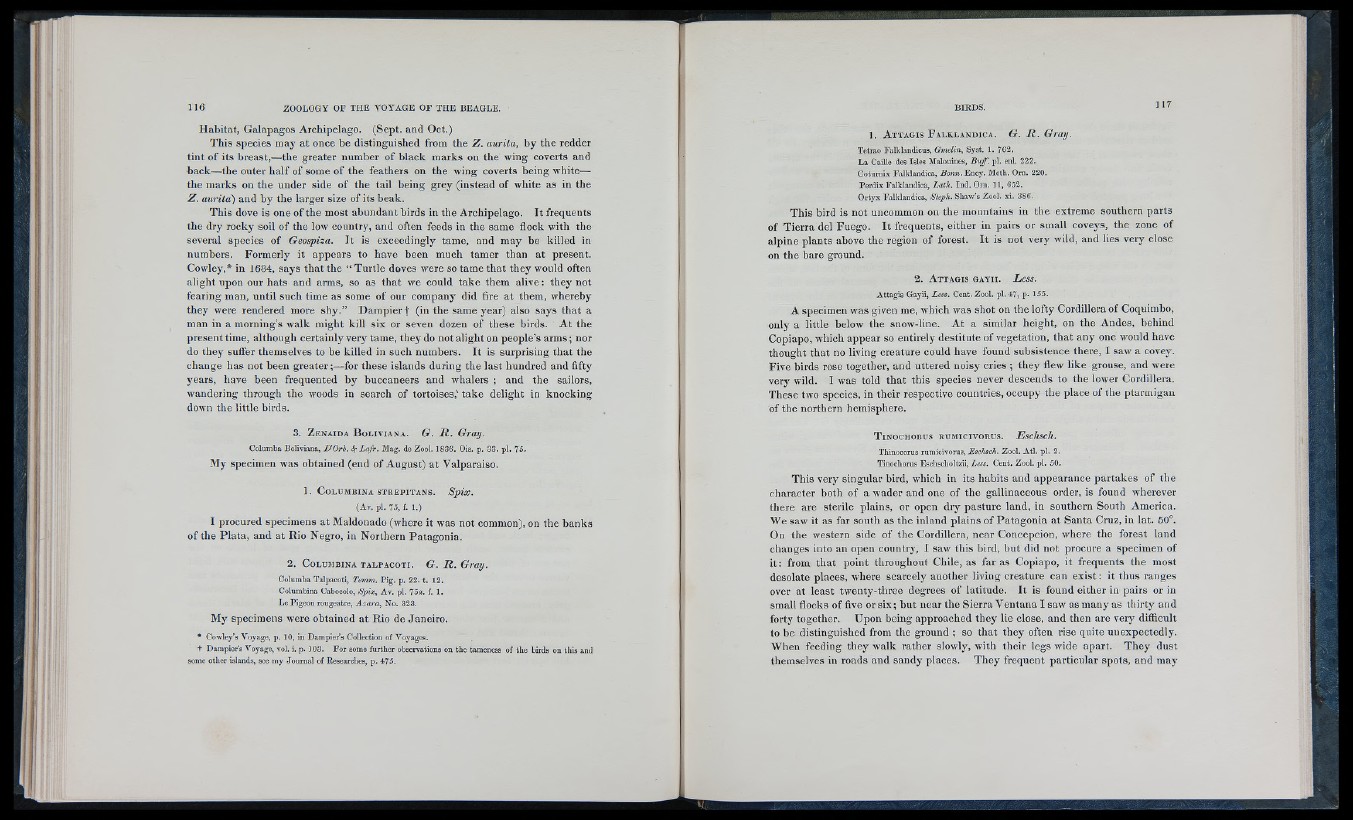
Habitat, Galapagos Archipelago. (Sept. and Oct.)
This species may at once be distinguished from the Z. aurita, by the redder
tint of its breast,—the greater number of black marks on the wing coverts and
back—the outer half of some of the feathers on the wing coverts being white—
the marks on the under side of the tail being grey (instead of white as in the
Z. aurita) and by the larger size of its beak.
This dove is one of the most abundant birds in the Archipelago. It frequents
the dry rocky soil of the low country, and often feeds in the same flock with the
several species of Geospiza. It is exceedingly tame, and may be killed in
numbers. Formerly it appears to have been much tamer than at present.
Cowley,* in 1684, says that the “ Turtle doves were so tame that they would often
alight upon our hats and arms, so as that we could take them alive : they not
fearing man, until such time as some of our company did fire at them, whereby
they were rendered more shy.” Dampierf (in the same year) also says that a
man in a morning’s walk might kill six or seven dozen of these birds. At the
present time, although certainly very tame, they do not alight on people’s arms ; nor
do they suffer themselves to be killed in such numbers. It is surprising that the
change has not been greater;—for these islands during the last hundred and fifty
years, have been frequented by buccaneers and whalers ; and the sailors,
wandering through the woods in search of tortoises,' take delight in knocking
down the little birds.
3 . Z e n a i d a B o l i v i a n a . G. R . Gray.
Columba Boliviana, D'Orh. Sf Lafr. Mag. de Zool. 1836. Ois. p. 33. pl. 75.
My specimen was obtained (end of August) at Valparaiso.
1 . C o l u m b i n a s t r e p i t a n s . Spix.
(Av. pl. 75, f. 1.)
I procured specimens at Maldonado (where it was not common), on the banks
of the Plata, and at Rio Negro, in Northern Patagonia.
2 . C o l u m b in a t a l p a c o t i . G. R . Gray.
Columba Talpacoti, Temm. Pig. p. 22. t. 12.
Columbina Cabocolo, Spix, Av. pl. 75a. f. 1.
Le Pigeon rougeâtre, Azara, No. 323.
My specimens were obtained at Rio de Janeiro.
• Cowley’s Voyage, p. 10, in Dampier’s Collection of Voyages.
t Dampier’s Voyage, vol. i. p. 103. For some further observations on the tameness of the birds on this and
some other islands, see my Journal of Researches, p. 475.
1 . A t t a g i s F a l k l a n d i c a . G. R . Gray.
Tetrao Falklandicus, Gmelin, Syst. 1. 762.
La Caille des Isles Malouines, Buff. pl. enl. 222.
Coturnix Falklandica, Bonn. Ency. Meth. Om. 220.
Perdix Falklandica, ZaiA. Ind. Orn. 11, 652.
Ortyx Falklandica, Steph. Shaw’s Zool. xi. 386.
This bird is not uncommon on the mountains in the extreme southern parts
of Tierra del Fuego. It frequents, either in pairs or small coveys, the zone of
alpine plants above the region of forest. It is not very wild, and lies very close
on the bare ground.
2 . A t t a g i s g a y i i . Less.
Attagis Gayii, Less. Cent. Zool. pi. 47, p- 155.
A specimen was given me, which was shot on the lofty Cordillera of Coquimbo,
only a little below the snow-line. At a similar height, on the Andes, behind
Copiapo, which appear so entirely destitute of vegetation, that any one would have
thought that no living creature could have found subsistence there, I saw a covey.
Five birds rose together, and uttered noisy cries ; they flew like grouse, and were
very wild. I was told that this species never descends to the lower Cordillera.
These two species, in their respective countries, occupy the place of the ptarmigan
of the northern hemisphere.
T in o c h o r u s r u m ic iv o r u s . Eschsch.
Thinocorus rumicivoms, Eschsch. Zool. Atl. pl. 2.
Tinochorus Eschscholtzii, Cent. Zool. pl. 50.
This very singular bird, which in its habits and appearance partakes of the
character both of a wader and one of the gallinaceous order, is found wherever
there are sterile plains, or open diy pasture land, in southern South America.
We saw it as far south as the inland plains of Patagonia at Santa Cruz, in lat. 50°.
On the western side of the Cordillera, near Concepcion, where the forest land
changes into an open country, I saw this bird, but did not procure a specimen of
it: from that point throughout Chile, as far as Copiapo, it frequents the most
desolate places, where scarcely another living creature can exist: it thus ranges
over at least twenty-three degrees of latitude. It is found either in pairs or in
small flocks of five or s ix ; but near the Sierra Ventana I saw as many as thirty and
forty together. Upon being approached they lie close, and then are very difficult
to be distinguished from the ground ; so that they often rise quite unexpectedly.
When feeding they walk rather slowly, with their legs wide apart. They dust
themselves in roads and sandy places. They frequent particular spots, and may